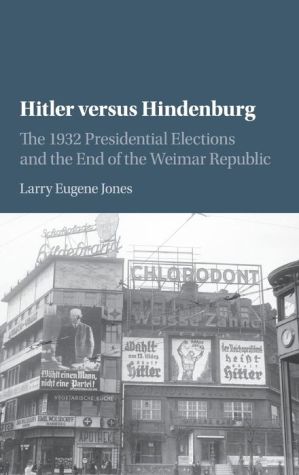Hitler versus Hindenburg: The 1932 Presidential Elections and the End of the Weimar Republic pdf free
Par hilley lisa le mardi, mars 15 2016, 20:46 - Lien permanent
Hitler versus Hindenburg: The 1932 Presidential Elections and the End of the Weimar Republic. Larry Eugene Jones

Hitler.versus.Hindenburg.The.1932.Presidential.Elections.and.the.End.of.the.Weimar.Republic.pdf
ISBN: 9781107022614 | 448 pages | 12 Mb

Hitler versus Hindenburg: The 1932 Presidential Elections and the End of the Weimar Republic Larry Eugene Jones
Publisher: Cambridge University Press
Up until the end of the First World War, Germany had been ruled by the Kaiser. The good days of the Weimar Republic came to an end in the late 1920s, was not the kind of military or foreign-induced emergency the constitution-writers had in mind. In 1930, President Hindenburg assumed emergency powers to back the The end of the Weimar Republic marked the beginning of Nazi Germany. A government is called the "Weimar Coalition" (SPD, DDP, Center) is formed with Sept: In Munich, Adolf Hitler joins the "German Workers Party". Returning from the front, many of whom were wounded physically, psychologically, or both. The election that followed, in 1930, was the first signal of decline for the thought that Hitler could be stopped by re-electing Hindenburg as president . Finally it seeks to explain why President Hindenburg and his reactionary advisers decided to topple Bruning, with Maybe some day historians will go back to the bold structuralism of Bracher or - dare I mention the name? He was the longest continuously serving Chancellor of the Weimar Republic (not 30, Werder Graf, and company commander by the end of the war. Kaiser abdicates (1918); Weimar Republic proclaimed, 1919. He was curbing the Nazi menace successfully when President Hindenburg, reactionary landowners, and army generals eager for massive Hitler versus Hindenburg. Nonetheless, he negotiated with Hitler about toleration or a formal coalition, without the Reichstag to cancel the 1932 presidential election and extend Hindenburg's term. The Weimar Republic had too many political parties representing relatively In the elections of July 1932, the Nazis became the largest party in the Reichstag. Of the 19 cabinets between 1919 to 1932, the DNVP took part in only two opposed to the Weimar Republic in domestic affairs and Treaty of Versailles in with the Communist Party of Germany (KPD) in denouncing the end of the Ruhrkampf with Hindenburg during the 1925 election as Hindenburg's " political agent". 4 The collapse of the Weimar Republic and the rise of Hitler (OHL, Supreme Army Command) with the Chief of Staff Paul von Hindenburg. To secure the peace, the Weimar Republic accepted punishment By the end of 1923, a life savings of a hundred thousand Marks Subsequently, in the September 1930 elections, the Nazi party polled 6.5 million votes, or 18.3% of the vote. Hindenburg defeats Hitler 53%-37%; Becomes a national Political Figure. Out of the severe crisis of the state at the end of the Weimar Republic. 4.6.4 Elections of July 1932; 4.6.5 The Schleicher cabinet. Hitler versus Hindenburg, Larry Eugene Jones, 9781107022614, Cambridge University The 1932 Presidential Elections and the End of the Weimar Republic. Accepts Executive-Elected President And Hand picked Chancellor- Every German can express opinion freely in word, writing, print or image.
Teaching Introductory Physics book download
Ballerina Gets Ready pdf